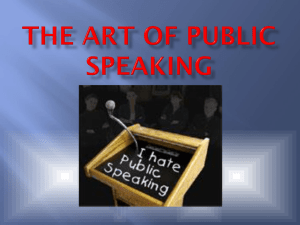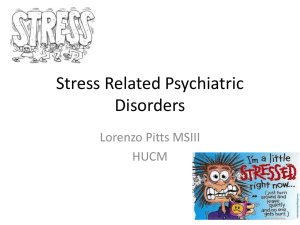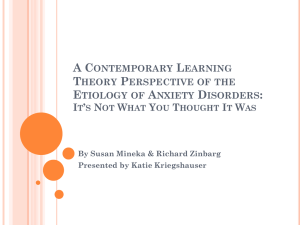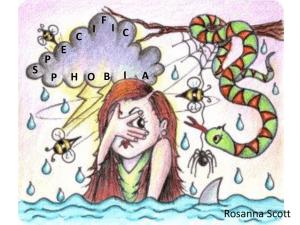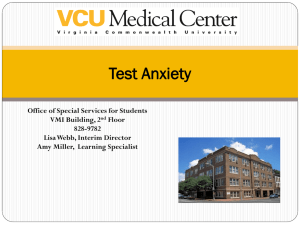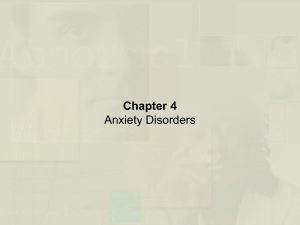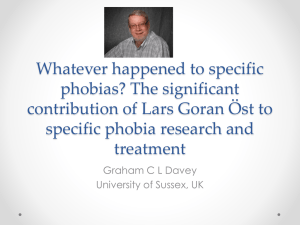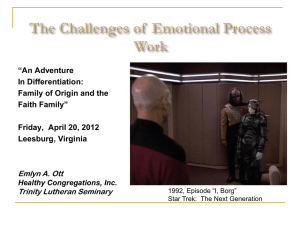Anxiety-School Phobia
advertisement
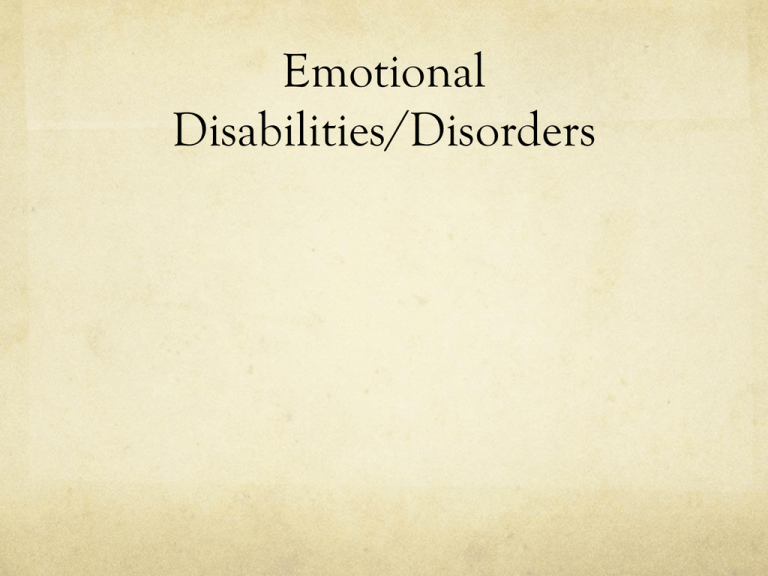
Emotional Disabilities/Disorders Arousal Level Optimal performance Optimal arousal Stress zone Bored zone Underaroused (low) CD ADHD Overaroused (high) Anxiety Asperger’s Autism 4/9/2015 Anxiety 3 Anxiety Definition An unpleasant state involving: 1. subjective apprehension and 2. physiological arousal of a diffuse nature. When is Anxiety a Disorder? Duration--over 2 years Intensity (impairs academic or social functioning) Etiology or causes: 1. Nature (heredity) sensitive personality 2. Nurture (learning) a. Social observation of others (dog bite) b. Own experiences (trauma, divorce) C. Skill deficits (LD), physical problems) ACAdemics 1. Academics failure (4 times greater high anxious ) Selective attention to: Safety, Competence Evaluator 2. Depends on Task Complexity Simple good Complex poor # of problems Reading Group-paced Communication Incidental learning TYPES OF ED ANXIETY DISORDERS Generalized anxiety/overanxious disorder Panic disorder OCD (Obsessions/Depressions) Posttraumatic stress disorder (PTSD) Specific Separation anxiety & school phobia Phobias specific ‘things’ like spiders, elevators Person Anxieties (social phobia, agoraphobia) Post Traumatic Stress Disorder Subtype: POSTTRAUMATIC STRESS DISORDER Result of some devastating event--devastating events include experiencing or witnessing assaults, natural catastrophes, rape, suicide, life-threatening illness, war, etc. Symptoms may be immediate or delayed--includes sense of reliving the experience, illusions, flashbacks, etc. In young children, recollections can be expressed through repetitive play with themes of trauma POSTTRAUMATIC STRESS DISORDER Symptoms of avoidance: (1) avoid thoughts, feelings or conversations of the trauma, (2) avoid activities, places or people that arouse recollections of trauma, (3) inability to recall important aspects of the trauma, (4) markedly diminished interest or participation in activities, (5) feeling of detachment or estrangement from others, (6) restricted range of affect, (7) sense of a foreshortened future (not expect to have career, marriage, kids), Symptoms of arousal: (1) difficulty falling or staying asleep, (2) irritability or outbursts of anger, (3) difficulty concentrating, (4) hypervigilant, and (5) exaggerated startle response 11 School Refusal broad category: 1. Separation Anxiety 2. School Phobia 3. Truancy Two categories of school refusal 12 1. Internalizing Seeks comfort of home School phobic child really WANTS to go to school, just unable to do so. 2. Externalizing Avoids home “Truancy” What Possible Disorder? 14 Functional Etiology: Why avoid school? Avoid a negative 1. Loss of parent 2. Tests/evaluations 3. Social situations 4. Performing before a group Obtain a positive 1. Stay home with parent and receive attention 2. Watch TV or play Experience Contributors 16 1. Life changing events a) b) c) d) e) 2. 3. 4. death in the family, birth of a sibling, move, parent losing job, unstable or divorced families Failure oriented classroom -- child is punished for trying and failing and punished for not trying Transitions (start of kindergarten, junior or sr. high school). School breaks, holidays, summer vacation -- symptoms worse on Sunday evenings and Monday mornings, or after vacation Family Contributors 17 Mothers are more likely to be diagnosed with anxiety disorders Parents have unrealistic expectations of academic success SCHOOL PHOBIA: Matilda Matilda enjoyed school until her parents notified her that they were having a baby. Matilda missed at least 20 days every school year after her younger sister was born. Her parents divorced when she was in fourth grade. Her attempts at absenteeism escalated. She continued to try to stay home from school saying she had stomachaches and headaches. She was a straight A student. By the time Matilda reached high school, her mother was tired of fighting her about school attendance and let Matilda stay home whenever she wanted as her grades did not suffer. Matilda’s outcomes Matilda graduated as valedictorian of her high school and college classes. Her professors were understanding of her frequent absences, as she was such a good student. When Matilda graduated from college, she was unable to keep a steady job.. Her employers were not as generous as her teachers had been. By the time Matilda was 31 years old she had had at least fifty jobs. Most of those jobs she held for less than a month. Long Term Outcomes 20 If School Phobia is not treated: Family problems: Parents may have to quit job; see school phobia as WORSE than CD Siblings are affected as parents’ attention is focused on the child with school phobia. Student outcomes: leads to more generalized anxiety disorder, depression, phobic disorders, such as agoraphobia. predicts occupational, social, and marital problems Accommodations-School Phobia 1. The school environment may be causing anxiety, so investigate the child’s fears: reduce pressure; a good relationship with the teacher can help the student return to school; 2. Practice relaxation techniques in the classroom. 3. Sit the child by the door, so he/she can leave the room when feeling anxious. 4. Give practice tests 5. Allow extra-curricular activities even when they miss school. 21 22 Interventions Anxiety disorders have a high rate of recovery if treated. School phobia should be treated right away, as the child’s fear will continue to build. Interventions School Phobia 23 Behavioral and cognitive treatments are 93% successful while only 37% of the hospitalized group and 10% of the home school/psychotherapy group were successful. Treat the student in the fear provoking setting, using gradual reintroduction into school . Focus on long-term goals, like the ability to attend school full time, rather than on immediate academic concerns Behavioral contracting--baby steps and reinforce attendance Do not reinforce crying or complaints of physical symptoms. Be firm but gentle. SOCIAL PHOBIA PERSON ANXIETY involves social avoidance 1. Shy, 2. Social Phobic, 3. Agoraphobic Two subtypes of Social Phobia Fears that he or she may do something in a way that will be humiliating. Specific (restroom, writing, speaking) General (hallways, cafeteria) Background on Robert White, male, 17 years old, senior at West Side School LD in Lang. Art Gifted in Math and Computers Social Difficulties Family Contributions Recently moved Family tragedy (Due to the death of his younger brother Robert’s mother tends to shelter him and keeps him from social situations). Weird behavior Moans, mumbles, and laughs Doesn’t answer/ mute Walks away Selectively silent to avoid fearful settings SETTINGS THAT TRIGGER Being approached Being asked a question Being forced to interact Being graded in class for participation Other Social Phobic Characteristics: 1. doesn’t have any interpersonal relationships. 2. seems depressed --says that he hates his life. 3. was asked to be a chairman of the Robotics team but declined. Classes that lead to abnormal behavior Classes That Grade Particpation 10% 90% 1 Classes that don't grade participation 2 Classes that grade participation Observable Consequences 1. Left alone 2. Doesn’t have to produce 3. Teacher attention Payoff Data Psychobiological Payoffs 15% 47% 38% 1 Avoid lack of control 2 Avoid failure 3 Get adult attention DSM IV Definition of Social Phobia & Robert A marked and persistent fear of one or more social situation or performance situations in the person is exposed to unfamiliar people of scrutiny by others 1. Marked fear in more than on social situation and is worried about how other’s view him. 2. Exposure to feared situation provokes a panic attack 2. Exposure to feared situation causes his moans, mumbles, and weird laugh. 3. Person recognizes that the fear is excessive or unreasonable 3. Robert does recognize that his fear is excessive and unreasonable 4. The fear situations are avoided or else endured with great anxiety 4. Robert avoids situations that might make him uncomfortable (speeches, group projects, games, etc..) 1. 5. The fear, avoidance, or anticipation interferes with the person’s normal routine, occupation, relationships, or situations that 5. would otherwise not be effected by a normal person Robert’s avoidance at times interferes with his life and most often interferes with his academic success. 6. Individuals under 18 years old and duration 6. longer that 6 months Robert has had these characteristic since I first met him last year. 7. The fear is NOT due to another substance, 7. medical condition of and is not better accounted for by another mental disorder. Robert does not have another medical condition that could explain his behavior and his behavior cannot be better accounted for under another mental condition. 8. If a medical condition or other mental disorder is present the fear experienced is is unrelated to them. Persistent refusal to speak despite the ability to speak and comprehend spoken language. Types Unduly shy in the company of acquaintances or relatives May be a symptom of social phobia rather than a separate diagnostic category. Contributors Contributors Family psychopathology (mother depressed & overprotect) and father shy temperament Temperament (shy & anxious) Presenting Problem Developmental Delay (elimination problems) Speech and Language LD (20%) Not Speaking in at least one Social Situations (usually classroom) Versus Experience of Trauma Behavioral INTERVENTIONS 1. Systematic desensitization-gradual and repeated exposure to the fear-producing stimuli (either in real life or in purposeful fantasy) and in an activity that is incompatible with anxiety (relaxing in a favorite chair, eating ice cream). 2. Reconditioning through role play, reinforcement for facing object of fear, matter-of-fact statements that child will “go back to school” for instance, removal of reinforcers for avoiding object of fear (e.g., can’t watch TV if at home) 3. Guided participation or practice--introduce other persons as models with the feared stimulus (e.g., videotapes of person with a dog and then with a dog under highly supervised conditions). Other Interventions 1. Flooding or implosion-- high frequency exposure to feared objects 2. Self-control training--may learn relaxation, selfreinforcement, self-punishment, self-instruction, visual imagery, or problem solving strats. Children taught to (1) recognize anxious feelings and physical reactions, (2) modify cognitions and misperceptions that contribute to anxiety, (3) Reinforce self for making change 3. Pharmacology 4. Expressive Therapies Art, Music, Drama, Dance, bibliotherapy where books are used to provide models of coping. (e.g.,. On divorce, going to the hospital) Websites: -www.drjplowman.co.uk -www.phobics-society-org.uk -www.openmind-rossendale.co.uk
